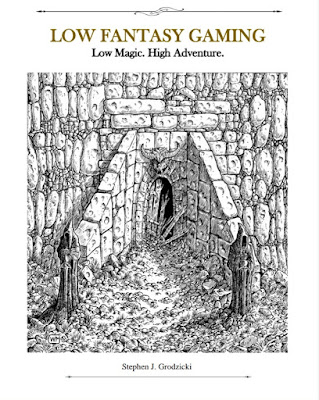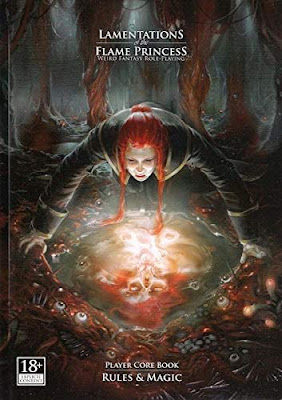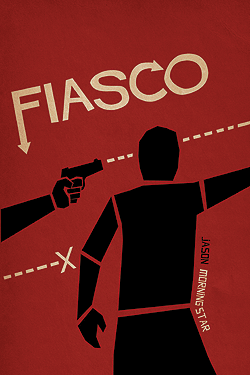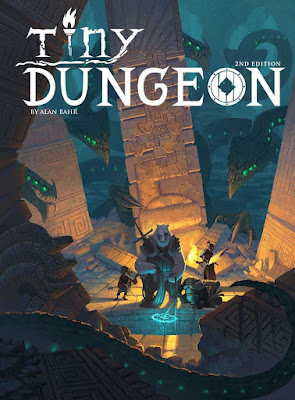Friday night while chatting with my wife (who's has avid a gamer as I am,) I ended up discussing what I like about my favorite OSR systems, and my favorite NON-OSR Indie and small developer systems. It turned into kind of a "round up," and I thought I would share it here in a slightly more polished form.
This article isn't as objective as the reviews I usually offer. It's very much subject to my own taste. But, I hope it might help you find games you enjoy if you're anything like me.
My Top Five Old-School Renaissance Games
I love OSR games. I love seeing people take old systems and make them new again with innovations or a change in aesthetic and setting. The Old school Renaissance isn't about taking an old system, adding a bunch of house rules, and packaging it for sale. (Although there are some of those out there.) It is about using the open source language of Basic /Expert or Advanced D&D to create something different. Thus, my favorite OSR games both are familiar, on some levels, and totally new on others.
Dungeon Crawl Classics RPG
 |
| Dungeon Crawl Classics RPG cover Art by Doug Kovacs; ©2012 Goodman Games |
Structurally, DCC RPG is a mutation of Dungeons & Dragons 3rd Ed. with most of the fat trimmed off. It has no skill system, just a character occupation. It uses the simple three saving throw system. And has a Luck statistic that player characters can expend that replaces a huge amount of the pre-existing mechanics.
Dungeon Crawl Classics RPG is a real joy to play. And it definitely creates high-octane and fun pulp fiction. Is engages with Pulp tropes that Dungeons & Dragons never quite figured out how to deploy, such as highly chaotic magic, a simple unified mechanic for swashbuckling moves in battle, a visceral system of critical hits, and non-human characters that feel strange and special.
DCC RPG is greatly enhanced by the incredibly enthusiastic community, volume up pretty content. Goodman Games regularly releases modules for this game that are weird, surreal, and darkly funny. Each one is a joy to read and features maps and art from some of the best creative minds in the industry.
This game is more than just a retroclone, it is a reimagining of D&D from the ground up while still using familiar mechanics. It is also highly lethal, Player Characters are often scheming mercenaries rather than Heroes, and the adventures are often anti-heroic.
DCC RPG has serious flaws in the way it is written. But overall, is a very playable and enjoyable.
Low Fantasy Gaming
 |
| Low Fantasy Gaming cover ©2016 Pickpocket Press |
Low Fantasy Gaming, like DCC RPG, offers rules for spells going wrong, unpredictable magic, and especially straightforward rules for thrilling heroics. If you want to dive to get between an allied harm, jump in the way of a villain has he races for an innocent, or drop a chandelier on your enemies by cutting a support rope, this game has you covered very intelligently.
The LFG community is relatively small, but it is very innovative, there hasn't been a month I haven't seen some clever and creative hacks for the game.
I have been playing this game for well over a year now, and I will assert that in actual game play this game absolutely rocks. Especially if what you want is heavy on dungeon crawling and tactically sophisticated battles (even while playing Theater of the Mind.)
Index Card RPG Core
 |
| Index Card RPG Master Edition cover Art by Hankerin Ferinale ©2021 Runehammer Games |
Overall ICRPG has evolved so far from its D&D5e roots that it is no longer remotely recognizable as the same thing. It is faster, lighter, and more versatile. And even if it is not used on its own, the innovations in it are well worth considering as Hacks for whatever system you are playing.
ICRPG Core is future-proofed. Hankerin Ferinale and his company RUNEHAMMER offered free PDF copies of ICRPG Core 2e to anyone who had purchased the original Index Card RPG Core. Once he released ICRPG Core Master Edition, he offered a new core book to all purchasers of ICRPG Core 2e, that included all of the updated rules and updates to the two systems included in 2e. (The Master Edition itself includes three additional settings not included in the update book.) This policy of giving players updates so they can enjoy the new edition is radical, and has definitely made me a fan.
I have played around 250 hours of ICRPG Core over the last year, and have enjoyed it considerably.
Lamentations of the Flame Princess
 |
| Lamentations of the Flame Princess cover Artt by Cynthia Sheppard ©2013 Lamentations of the Flame Princess |
What really sets LotFP apart, however is it's aesthetic design. Internally, LotFP games are darker and stranger: they are focused on creating a "Weird Fiction" feel rather than classic fantasy or Sword & Sorcery. The manuals are filled with dark, often gory or highly sexualized art (sometimes both at once.) The magic is often dark and dangerous.
LotFP adventures are often strange, disturbing, and full of bizarre hazards and traps. Meddling with anything in the environment in LotFP are equally likely to grant superheroic abilities or kill your characters. Many modules offer players at least one way to accidentally destroy the world for good measure. A high lethality rate is common. Most are set on historical Earth in the 17th Century, rather than a fantasy setting. Most are also very combat light, and work as well for 1st as 9th level characters.
The Dark "Death Metal" and "satanic" aesthetics that Lamentations of the Flame Princess brings to the table have made undeniably as much Art as game, and designed to have a strong appeal to older gamers who have a good chance of being meatalheds and horror film fans (like me.)
LotFP also pioneered the "Tentpole Adventure" aesthetic of using only one monster in a complex or terrifying environment. And making sure that monster is not something common or recognizable from traditional fantasy tropes.
All print LotFP products are premium quality books: printed in A5 comment on glossy, low-acid paper with stitched bindings and hard covers. Colour art is a common feature, and where ti isn't there, faux leather embossed covers, slipcases, or ornate layout more than make up for it.
As a company, Lamentations of the Flame Princess is also significant insofar as it allows it creative to retain the rights to work and offers large royalty payments instead of the often exploitative pay-for-work moel used by industry giants like Wizards fo the Coast. The benefits fo working for LotFP make it far more attractive to a Creative designer than working for a giant like Paizo or izards ever could. It s slowly changing the whole way the industry works.
Crimson Dragon Slayer d20 Expanded
 |
| Cha'alt Fuchsia Malaise cover Art by Monstark ©2020 Kort'thalis Publishing |
LThis is the engine that Venger Satanis includes in Cha'alt, and then vastly expanded and improved in Cha'alt Fuchsia Malaise. Designed to be played without need for a character sheet, this system will be instantly relatable to 5e players, but is definitely distilled down to a bare minimum. It uses only the four basic classes (Fighter, Cleric, Thief, and Sorcerer), and offers an extensive list of races (but ones that only have one benefit.)
Thief abilities automatically succeed if the task is reasonably straightforward, and require a roll only if there are a lot of mitigating circumstance. Sorcerers can cast any of the common spells, but they cost hit points to cast: either their own, or if the Spell is cast as a 3-round ritual, someone else's. Fighters improve attack and damage with level and can pull of Swashbuckling moves with advantage on their d20 rolls so long as they are well-narrated. Clerics have unlimited healing... but there Is a chance that their healing can fail and leave them without the ability for 10-40 minutes. they also have destructive energy beams and mind control that works on undead and extraplanar creatures only.
Combined with a flat universal DC of 15 on all Non-Combat tasks (and guidelines on rolling only when necessary), class-based damage rolls, simplified levelling, and a single level-based saving throw, this game is lightning fast. Character building takes only a minute, and the game has enough meat to be satisfying without being complicated. It is the fastest OSR system I have ever experienced.
While Crimson Dragon Slayer d20 is free on its own, it is also included as an Appendix n Cha'alt and Cha'alt Fuchsia Malaise which offer a setting and adventures that are strange, pulpy, gonzo adventures that would not feel out of place in Heavy Metal Magazine. I do believe that this is the best way to get your hands on the system, as Cha'alt sets the tone beautifully.
My Top 5 Non-OSR Indie Games
The tag line on this blog is OSR Gaming for Lazy GMs... Which is not really how the blog worked out. I don't think I will ever drop "OSR" though, because I am always going to be a D&D kid at heart. But I love learn wand trying new things. Especially new games. I have played over 40 different TTRPGs and I am better for it. I definitely like talking about them here when I think there is something relevant for a GM.
Blades in the Dark
 |
| Blades in the Dark cover Art by John Harper ©2017 Evil Hat |
It has a secondary play loop for building up a gang of henchmen, claiming turf, and building influence and sources that can drive PCs in-heist decisions, and allows PCs to ultimately dominate one kind of crime across a quarter of the settings' core city. This is an incredible evolution of dominion-level play that I have imported into several of my games.
BitD has one of the best settings I have ever read, simple mechanics, and a great system for creating self-motivating PCs. The GM can often let the dice fall where they may and wind up with an incredibly complex emergent narrative with minimal guidance.
It suffers from a deep distrust of the GM reflected in the game's structure and a mountain of nonsensical jargon that hurts the overall elegance of the game.
Blades in the Dark was the first game to be built on the Forged in the Dark engine, which is an open-source game engine that has been used to create a plethora of other Storygames such as Scum and Villainy and Band of Blades.
Fiasco
Fiasco from Bully Pulpit is a cooperative, GMless game designed to create an emergent story of crime and corruption that ends in disaster for the PCs in the vein of a Cohen Brothers movie. It requires little setup, and only a handful of dice of two different colors per player.
 |
| Fiasco cover Art by John Harper ©2009 Jason Morningstar |
At the end of which a complex scenario has organically developed out of the set of relationships, desires, and McGuffin that have been established.
Player's then take turns choosing whether to establish a scene of their choosing or have another player describe it for them. They then interact with the characters included in the scenario. (NPCs, if required, are controlled by a player whose PC is not present.) Eventually a player votes as to whether the scene goes well or badly for the PC whose turn it is, by giving them an appropriately-coloured die.
At the end of the game, when all dice are depleted, players roll their total accumulated "good" and "bad result dice" then subtract the total of the bad from the good to get a result ranging from "a fate worse than death" to "all your wishes come true", and each character takes a turn narrating how that turned out for their specific PC.
Fiasco is strongly in the "Storygame" camp, but it's speed and sheer creativity make it a great activity for four friends with virtually no prep.
Overlight: The Roleplaying Game of Kaleidoscopic Journeys
 |
| Overlight cover; Art by Kwanchai Moriya ©2018 Renegade Game Studios |
Set in a fractured world of floating islands lit by a pillar of holy light, PCs are the Skyborn, people who can perform miracles far more potent than the everyday magic that the common folk can manage,
But who are, by nature, misfits and compelled to use those powers for good and evil.
While it's mechanics are needlessly complex, many of the design ideas and concepts of this game offer something that is worth playing.
I also will say that it is one of the most beautiful TTRPG manuals that I own.
With strange, alien themes, a unique way at looking at spirituality and divinity in a role-playing game, and a system that rewards exploration over combat, Overlight is a great game for parting with preconceptions about how fantasy can be played at the table.
Tiny Dungeon
 |
| Tiny Dungeon 2e Cover; Art by Michael Leavenworth ©2018 Gallant Knight Games |
Tiny Dungeon 2e is fast, simple, and satisfying. It has been a go-to for playing games with my sons for quite some time now. It is a great pickup game in a pinch. My hardcopy tends to travel with me when taking my family anywhere.
Alan Bahr has variants of this game for Space Opera, Post-apocalyptic Survival, Mecha Warfare, Cyberpunk, and Lovecraftian Horror through Gallant Knight Games. The Tiny D6 System lends itself to almost any genre, so long as the GM is flexible. I have become a bit of a collector of Tiny D6 material.
After its recent feature on Dungeoncraft, I am glad that Tiny Dungeon is finally getting the recognition it deserves. It also has a regular zine of community-submitted and author-curated material that offers a lot of expanded systems, character traits and adventure ideas for the system. And has a specifically kid-friendly version of the game: Tiny Dungeon: Hatchling Edition.
Numenéra
Numenéra cover; Art by Kieran Yanner
©2013 Monte Cook Games
Numenéra is the first Monte Cook Games offering to use their incredibly simple and flexible Cypher System. This engine is fast and simple to use, and very easy to write for. Other games such as Cypher System, The Strange, and No Thank You, Evil! using the system are usually outstanding design.
What sets Numenéra at the forefront though is its setting. Numenéra is a sword-and-planet game where extinct humanity has been restored to Earth one billion years in the future. The planet is covered with the ruins and technology of dozens of now-dead civilizations, human and alien, that throve then perished. These previous "worlds" behind technological wonders, genetically engineered terrors, and strange interdimensional phenomena.
With only a couple of hundred years of history, humankind has become a race of scavengers; they live with mostly Medieval levels of technology, but most communities have one or two high-tech marvels that they have got up and running to enrich their lives, and some mystics such as the Aeon Priests can take shattered remains of advanced technology and turn them into devices that have incredible effects. One-use magical devices, Cyphers, can be found everywhere, and are the tool of choice for clever scavengers and adventurers.
I got hooked on Numenéra's setting and expansion books, and own most of the releases for the first edition of the game (Now in its second edition, which tidies up the rules and adds domain - level play.) I find them a pleasure to read, and the game a pleasure to run.

I need to check out Low Fantasy, I haven't yet. I like how fighters are treated in DCC, so I should check it out. ICRPG is a hugely creative take on the d20 system, I like it. Dude, Hankerin's DM section is worth the buy, just for that section.
ReplyDeleteI've not checked out that Cha'alt system yet either, I'll have to.
For my list, as I've talked of extensively, I go for the pick up and play quality above all:
-Maze Rats and Knave.
-Black Pudding, Heavy Helping. That book has a section outlining how he runs B/X style games.
-5 Torches Deep: Simple d20. I like the character options.
-Into the Odd, especially the variant Stay Frosty, which flips the ability scores so it's a roll over instead of roll under. I like rolling high. So, when you roll your abilities, you want to roll low. After that, it's all roll high. So a Strength 13 character needs to roll 13+ to succeed on a strength roll. So this keeps the roll of 1 sucks and a nat 20 is awesome, which, to me, is kinda important. :-)
-OSE: Not really an OSR game, but a restatement of B/X. I started with Red Box, so for me this is the gold standard.
I mostly DM my own homebrew game, a stripped down d20, I haven't gotten to play much of anything else.
Great choices!
Delete🤘 Knave is such an amazing design. I have borrowed a lot from it for my own upcoming system.
🤘 I have not had a good look at 5 Torches Deep, but I have critiqued a module for a friend. Looks pretty smart. Resource management is such an underrated part of play. When you respect it the way 5TD does it is a far more engaging experience.
🤘 I am actually planning three articles on Into the Odd this month! November is Game Engine month.
🤘 I am amazed at how much good organization makes a difference to how appealing a ruleset can be. I have the demo, and a copy of his original "B/X Essentials". I keep hoping that Exalted Funeral's shipping to Canada might actually become affordable so I can have it handy for when my sons are ready to learn.
🤘I'm totally ignorant of Black Pudding. Fixing that right now.
You can get Black Pudding here: It's a bunch of zines, basically. Issues 1-4 are organized into Heavy Helping, but you can get each zine bit by bit, there are 6 last time I checked.
Deletehttps://www.drivethrurpg.com/product/199081/Black-Pudding-1
Hey have you checked out what Hankerin is running right now? He's running OSE, and making heavy use of the roll under optional rules from page 104 of the OSE Rules Tome.
ReplyDeleteI had no idea roll under went all the way back to BX. Now I'm off to search my Cyclopedia and Red Box. Lol. :-)
Yup. Cyclopedia has it too. Ability checks are roll under attribute.
DeleteOkay, enough nerd diving for one night.
I used to watch Hankerin religiously, but when he moved to the hour-plus time format, it got a lot more difficult to find the time.
DeleteI really need to take a few hours and catch up...
When I was a kid playing the Red Box I was lucky to have players who constantly tried weird, outside-of-the-box solutions for everything. Roll-under became more common than attack rolls or saves in my campaigns by the time I was eight. I remember wondering why we were bothering with other mechanics. But at that age I didn't feel confident about hacking rules.
Yeah you can play a pretty decent game with roll under for everything, with advantage and disadvantage for background and situation.
DeleteGood list. For me, Scarlet Heroes easily takes the cake.
ReplyDeleteThat looks like a game I could use, or at least pillage from. Thanks for pointing it out! Reading the quickstart now!
DeleteThanks for the mention, hoss!
ReplyDelete